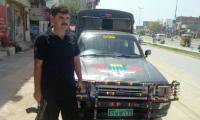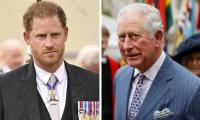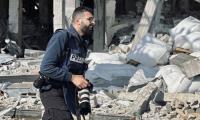Pakistan is locked in war. We do not always see it in the same way as a conventional war, with its mass destruction and its queues of refugees but the mob madness we saw recently by lawyers who attacked the Punjab Institute of Cardiology, the top free facility for heart patients in the Punjab, tore oxygen masks off the faces of patients in the ICU, beat doctors and caused the death of three patients genuinely makes us wonder if there is any sanity left.
The still photographs captured of the event are in some ways even more chilling than the video footage. They show female lawyers smiling, we assume admiringly, at their male colleagues as they brandish their sticks and head into the hospital. We see smiles on the faces of the men as they march to the hospital down the Mall Road and then Jail Road.
They know perfectly well what they will be doing. No authority steps forward to stop them. No one asks what the lawyers intend to do and of course action in the form of condemnation from the prime minister, the chief minister and FIRs against lawyers come much later after a media outcry. Most bizarrely of all, the PIC was closed down after the attack, leaving hapless attendants to take patients away in wheelchairs, trundle them onto the busy Jail Road and try and find transport to take them to a safer location. Some had come from as far away as Rawalpindi.
These mob armies have been growing. We have seen mobs in action after the blasphemy accusation against a Hindu doctor in Mirpurkhas; we saw it in April 2017 in the Mashal Khan case with its terrible outcome and we have seen it in many other places. There appears to be an increase in such lawlessness, perhaps because there is insufficient punitive action or because there is a sense that no rule of law exists and the state has lost its authority to control the lives of citizens.
In contrast to these mobs, we have also seen marches of a different kind. In November this year on a sunny Sunday, thousands of students marched peacefully through the streets of Lahore, Karachi, Rawalpindi, Quetta, Rawalakot and multiple other cities, bringing back memories of a time when students were an active and vibrant part of society. The red flags and banners, the Che Guevara masks and the berets with the star were also a reminder of a different time, a different age. A time of ideology and a time of open debate and discussion.
It was obvious that the young students, both girls and boys, only had a limited understanding of what the symbols they carried meant. History and ideology has after all been badly distorted in our curriculums. Cries of ‘Allah-o-Akbar’ were heard alongside calls of ‘comrade’ or other slogans speaking of equality or rights for the masses.
We then have two different kinds of forces on the march. We have the violent mobs represented by the lawyers and their reprehensible acts and we have the peaceful students whose slogans called for changes in campus, for lower fees to enable higher education for all, for an end to harassment of girls and for other actions to resolve the multiple issues that have cropped up on multiple campuses around the country.
Astonishingly, while the lawyers were allowed to enter the hospital, tear down IV poles and attack doctors and staff, the students were in many cases arrested, with 250 of them at least initially taken into custody and FIRs registered. Astonishingly, one of those held was Iqbal Lala, the elderly father of Mashal Khan who had travelled from Charsadda to Lahore to support the students and stand by them.
It is difficult to understand why peaceful persons attempting to bring change in society should be held; why an old man should be punished for joining those condemning the violent death of his son. We live in a country that is spiralling out of control. A kind of war is taking place between these groups made up on the one hand of mobs and on the other side of peaceful demonstrators.
Peaceful demonstrators have also marched on March 8, or International Women’s Day, raising slogans which created immense controversy in society that perhaps at least made people think – though this seems unlikely given the anger they spouted out. There were marches too for climate change, for the rights of labourers and for other causes.
This is naturally a welcome development. The question is if it can be carried forward or will the mobs which beat and shot Mashal Khan to death or forced the closure of a medical centre treating hundreds of severely sick people win out in the end?
There are many factors which will determine this. If student unions are allowed back on campuses, with the law put in place by the Sindh Assembly lifting the ban on them and allowing for elections on campus to choose student representatives who are independent of political parties, a lot could change. Such unions have the power to bring genuine change in society and perhaps most importantly of all generate debate within it.
Such debate could help them understand better what Che Guevara represented or what the hammer and sickle actually means. The friendly young marchers at the students march in Lahore were well-intentioned and spoke for the welfare of their fellows on campuses, but had a limited idea of ideological belief, the differences between it and even the idea that there could be many different interpretations of a single notion or a single set of beliefs.
Discussions amongst young people could help fix this and bring back the enlightenment we once saw in the 1960s and early 1970s when students took to the streets and were knowledgeable about a host of issues not only inside their country but also those taking place around the world.
We must hope with all the strength available to us that the peaceful protesters, those who seek change and betterment in the lives of people will win out. If the mobs are instead able to conduct havoc, with media reports stating that even PM Imran Khan’s nephew was one of the marching lawyers, then there is really no future left for us.
The battle has to be won and more people brought in to the picture so that a more orderly and more just state may potentially be created. This is not impossible. It can happen but needs will and commitment not just from a few but from many.
The writer is a freelance columnist and formernewspaper editor.
Email: kamilahyat@hotmail.com
India uses Afghanistan as a backstage area to carry out terrorist attacks against Pakistan
Another report by the Pakistan Institute of Peace Studies states that 78 per cent of attacks have been carried out by...
Pakistan stands at the forefront of this crisis, generating a staggering 3.3 million tonnes of plastic waste annually
Today, a total of 11,000 children are attending Daanish schools in Punjab
The emotional instability of parents inculcates a range of psychological issues in children
The current way of dealing with the environment and climate change is no longer adequate







